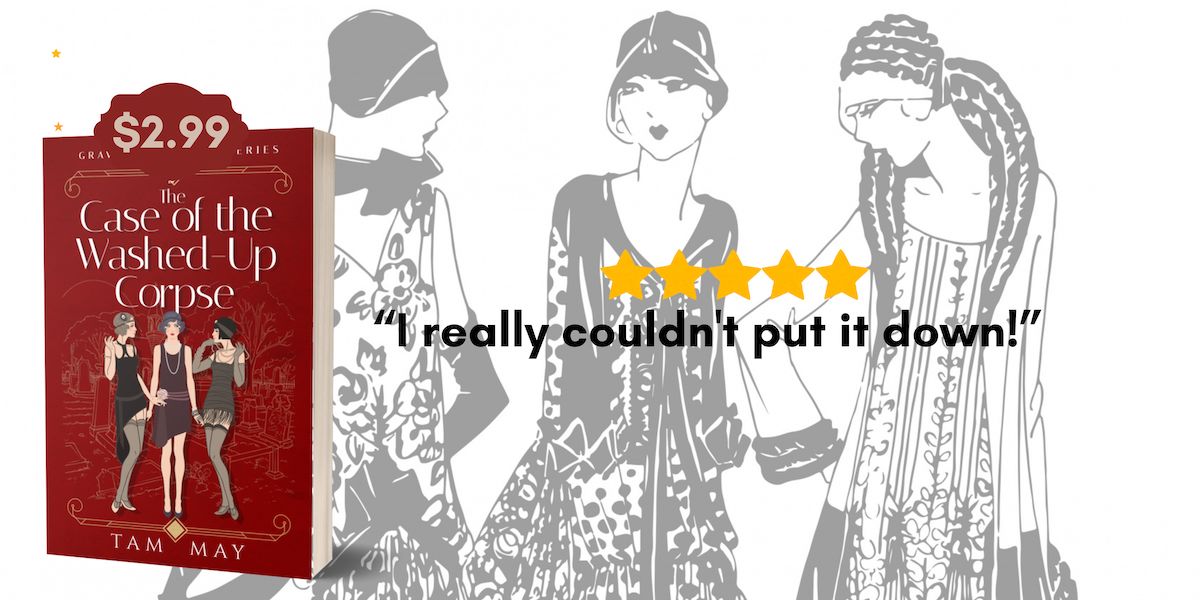
Title: The Missing Witness
Series:Series: Grave Sisters Mysteries: Book 2
Author: Tam May
Genres: Historical Cozy Mystery
Release Date: November 22, 2025
“It is an entertaining read.” — early Goodreads reviewer
In small towns like Gyver, WWI veterans don’t have it easy. In a nation just emerging from an economic depression, jobs are few and far between. Disability and shell shock are real, and battle fatigue is taking its toll on their bodies and souls.
Three years after the end of the war, Violet Grave’s friend, Hank Convoy, is one of these vets struggling to survive. With a grandmother and a disabled sister to support, he takes whatever odd jobs he can get. But like Violet, he’s a product of Jazz Age youth culture, so most of what he earns goes toward cards and bootleg liquor.
To add to his troubles, he’s arrested on suspicion of murdering an army buddy found in the alleyway near his house.
Violet begs her older sisters, Eve and Helena, to help prove Hank killed out of self-defense and not cold-blooded murder.
Will the sisters solve this confusing case based on cigar ash, a missing revolver, and some missing jewelry? And what about the witness who left the marks of a strange pair of shoes in the dirt the night it happened?
You can get your copy of the book at a special promotional price at the following online retailers.
Excerpt
Oliver persuaded Sheriff Warner to go down to Browly’s Diner for some sandwiches and coffee. He then coaxed Hank into eating. The food and coffee revived the young man a little.
But in spite of the district attorney’s compassion for the distraught young man, he didn’t forget he had an obligation to the county to do his duty. He felt the search for Wild Bill’s killer was over. And he was right.
When he and Sheriff Warner had settled into the room the police used for questioning suspects, the first words out of Hank’s mouth were, “I killed Wild Bill.”
“God Almighty, we figured that out a long time ago,” scoffed the sheriff.
“I’ll take over the questioning, Sheriff,” Oliver said in a rough tone. “Get your notebook ready, as we want to take all of this down.”
“Yes, sir,” The sheriff pulled out his notepad and pencil and straddled a chair across from Hank. “I’ll take it down myself.”
“You can take this down, Sheriff,” Hank said in a firm tone. “I had to kill Wild Bill to defend myself.”
Oliver heard the lawman mumble, “They all say that.”
“So you weren’t in Litt last night,” Oliver said. “And you didn’t get that wound from a bar fight.”
“I shouldn’t have lied,” said Hank. “I panicked.”
Oliver patted the young man’s arm. “Listen, son, do you want someone here with you?”
“I can’t afford a lawyer.” Hank suddenly broke down, hiding his face with both hands.
“I didn’t mean a lawyer,” Oliver said gently. “I meant a family member.”
“No one was home when we knocked on the door earlier this morning,” Sheriff Warner reminded him.
Hank stared at him. “What do you mean, no one was home?”
“No one answered,” he said.
The young man blinked. “Ellie’s always home unless she’s with Sarah Anthony.”
“She wasn’t with the Anthonys,” the sheriff said.
“You don’t understand.” He turned to Oliver. “Ellie’s blind, and she can’t walk well. Even if Granny was out, she wouldn’t leave her alone.”
“If she was home, she wasn’t answering the door,” Sheriff Warner said.
“Maybe Granny came back from the Solarises’ and took Ellie somewhere when she saw I wasn’t there,” Hank lamented.
“We can send someone to the Solarises’ to get them,” Oliver offered.
“It’s just as well they aren’t here.” Hank shook his head. “It would only upset Ellie.” He took a deep breath. “I don’t need anyone here. I want to tell what happened. It’s eating me up inside.”
“Start from the beginning,” Oliver said.
About the Author

Writing has been Tam May’s voice since the age of fourteen. She writes stories set in the past featuring sassy but sensitive women characters. Tam is the author of the Adele Gossling Mysteries, which takes place in the early 20th century and features suffragist and epistolary expert Adele Gossling whose talent for solving crimes doesn’t sit well with her town’s conventional ideas about women. She also has a new series, the Grave Sisters Mysteries, about three sisters who own a funeral home and help the county D.A. solve crimes in a 1920s small California town, set to release in 2025. In addition, she has written historical fiction about women breaking loose from the social and psychological expectations of their era. Although Tam left her heart in San Francisco, she lives in the Midwest because it’s cheaper. When she’s not writing, she’s devouring everything classic (books, films, art, music), concocting yummy plant-based dishes, and exploring her riverside town.
Social Media Links
Facebook: https://www.facebook.com/tammayauthor/
Instragram: https://www.instagram.com/tammayauthor/
Pinterest: https://www.pinterest.com/tammayauthor/
Amazon Author Page: https://www.amazon.com/Tam-May/e/B01N7BQZ9Y/
BookBub Author Page: https://www.bookbub.com/authors/tam-may
Goodreads Author Page: https://www.goodreads.com/author/show/16111197.Tam_May






